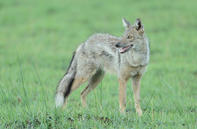
Name
Side-striped jackal [Canis adustus]Appearance
The side-striped jackal of South Africa is a species of jackal that is primarily nocturnal and timid in nature. It has a head and body length of 650-800 mm and tail length of 300-400 mm. It has a shoulder height 400-500 mm and weighs between 7-12 kg. This rarely seen carnivore is slightly bigger than the more common Black-backed jackal of South Africa. The side-striped jackal has a grey to buff coloured coat that is darker on the back with white stripes along its sides. It has a white-tipped tail and its ears are a dark buff colour.Diet
The side-striped jackal is omnivorous and is able to change its diet to adapt to its environmental conditions around South Africa. Its diet includes a variety of small mammals, carrion, small reptiles, eggs, birds, fruits and maize. They tend to be less predatory than the black-backed jackal.Breeding
The mating season for the side-striped jackal occurs during June and July in South Africa. However, some do mate throughout the year. The gestation period for the side-striped jackal is between 57-64 days.
A litter of around 4 to six pups are born during August and November. The young are reared by females, males and older pups born from the previous litter. Excavated termite mounds and old Aardvark burrows are used for dens to rear the young. Adults feed pups regurgitated food every 2-3 hours throughout the night.
 Learning about the mammals of South Africa is now so much easier for all South Africans - SouthAfrica.co.za is an excellent source of inform...
Learning about the mammals of South Africa is now so much easier for all South Africans - SouthAfrica.co.za is an excellent source of inform...